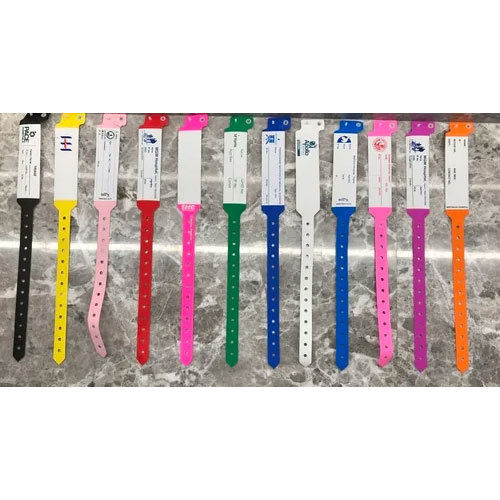The Significance of Using a Patient Identification Band in Modern Medical Practices
The Significance of Using a Patient Identification Band in Modern Medical Practices
Blog Article
Discovering the Various Sorts Of Patient Identification Band Used in Medical Facilities
In the intricate globe of health care, the critical duty of Patient Identification bands often goes unnoticed. These bands, differing from basic paper wristbands to sophisticated RFID bands, develop the backbone of Patient safety and security methods, guaranteeing accuracy in Patient Identification. Yet, the substantial diversity of these bands, each with its distinct benefits and restrictions, is commonly overlooked. As we navigate through this topic, one may obtain understanding into the refined complexities and essential value of such bands in medical centers.
Comprehending the Relevance of Patient Identification Bands
While they might appear like plain devices, Patient Identification bands play a vital role in clinical centers. These bands offer as an essential device for verifying Patient identity, preventing clinical mistakes associated to misidentification. Patient Identification bands also aid in streamlining management jobs, guaranteeing accurate record-keeping and billing.
Typical Paper Wristbands: Their Use and Limitations
Standard paper wristbands have been a staple in Patient Identification across numerous clinical facilities. While their use prevails, they harbor certain constraints that may impact their performance in Patient management. This area will focus on the extent of their application and the intrinsic disadvantages associated with their usage.
Paper Wristbands: Use Range
In the realm of Patient Identification, paper wristbands have long held an important role. These bands are normally made use of in outpatient setups, where the Patient's stay is momentary. Regardless of advancements in technology, the humble paper wristband stays a economical and trusted remedy for Patient Identification in numerous medical care circumstances.
Limitations of Paper Wristbands
Despite their widespread usage, paper wristbands are not without their drawbacks. Their physical resilience is among the significant limitations. Exposure to water, sweat, or misuse can render them unreadable and even cause them to disintegrate. In enhancement, paper wristbands often do not have the technical capacities of even more modern-day choices, such as barcoding or RFID chips, restricting their capability to just presenting created info. The failure to update or modify the data on the wristband is another shortcoming. If the details is transcribed, clarity can be jeopardized, leading to potential misidentification. Paper wristbands can create pain or skin irritation to some clients, particularly when worn for extensive durations.
Barcoded Wristbands: Advancements in Patient Identification
While Patient Identification has long been a vital element of health care, the development of barcoded wristbands indicates a substantial jump forward. These bands leverage the simplicity of barcoding technology, allowing for Patient information to be rapidly checked and accessed. They boost the rate and precision of Patient Identification, reducing the threat of medical errors related to misidentification.
Superhigh Frequency Identification (RFID) Bands: a Step Towards Futuristic Healthcare
The evolution of Patient Identification bands has actually brought about the development of Superhigh frequency Identification (RFID) Bands (patient identification band). These cutting-edge tools existing crucial benefits for health care facilities, supplying an extra efficient and technologically progressed methods of Patient Identification. The implementation of RFID in health care is a considerable step in the direction of a more advanced technique to Patient management and safety and security
Comprehending RFID Bands

RFID Bands: Key Benefits
Mainly, these bands boost Patient safety by offering precise, rapid Identification, thus minimizing clinical mistakes. RFID bands can store a vast quantity of Patient information, including medical history and allergies, allowing individualized treatment. Overall, RFID bands represent a considerable improvement in Patient Identification modern technology, profiting both patients and healthcare companies.
Carrying Out RFID in Medical Care
These bands provide a seamless means to track and identify people, ensuring their safety and security and boosting efficiency in treatment procedures. RFID bands lower medical mistakes by giving exact Patient Identification, which is critical in avoiding misdiagnosis or incorrect medicine management. Therefore, the implementation of RFID bands is a considerable step towards improving Patient security and medical care shipment.

Color-Coded Wristbands: Aiding in Quick and Accurate Diagnosis
In the bustling atmosphere of a clinical facility, color-coded wristbands have actually arised as important devices for swift and specific Identification of an individual's my website clinical condition. These wristbands, put on by clients, bring details colors that correspond to various clinical problems or standings. This system is made to offer instant aesthetic signs to healthcare carriers, enhancing Patient security and care quality.
Methods for Reliable Execution and Management of Patient ID Bands
Attaining ideal usage of Patient Identification bands requires a well-structured strategy for their execution and administration. Patient education is also critical; clients must comprehend the purpose of the bands and the demand for their constant wear. It's crucial to have a backup strategy in place, such as barcode scanning or biometrics, to make certain that Patient Identification is never endangered.
Conclusion
Patient Identification bands are important in medical centers to ensure security and accuracy. Conventional paper, barcoded, RFID, and click for source color-coded wristbands each hold one-of-a-kind advantages, varying from cost-effectiveness to advanced information storage space and immediate clinical alerts. Efficient execution and management of these bands can dramatically reduce medical mistakes, boost effectiveness, and boost overall Patient treatment. Hence, understanding and utilizing these Identification devices is paramount for preserving high criteria in medical care.
These bands, differing from simple paper wristbands to advanced RFID bands, develop the foundation of Patient safety protocols, making sure accuracy in Patient Identification.The development of Patient Identification bands has actually brought concerning the emergence of Radio Frequency Identification (RFID) Bands. On the whole, RFID bands stand for a substantial advancement in Patient Identification modern technology, profiting both people and medical care suppliers.
RFID bands reduce medical errors by supplying precise Patient Identification, which is crucial in protecting against misdiagnosis or wrong medicine management. Patient education is additionally important; patients must recognize the objective of the bands and the demand for their constant wear.
Report this page